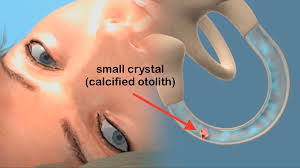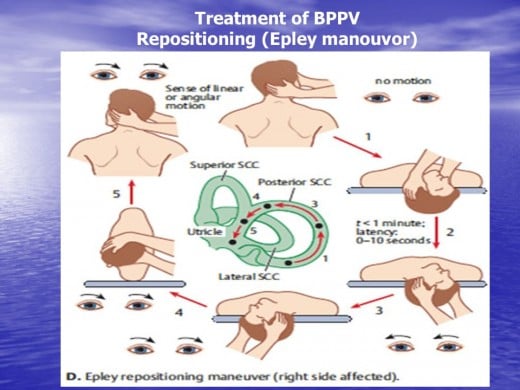Does your head spin as You Lie Down, Look Upwards, or Move Your Head? It Must Be Benign Paroxysmal Positional Vertigo!
Vertigo As You Lie Down?
A sensation of spinning, swirling and nausea – it can all be scary! If happening for the first time, and if it’s a violent episode of Benign Paroxysmal Positional Vertigo, it can be devastating and nerve-rattling! So, what is this Benign Paroxysmal Vertigo? What are the causes, symptoms, and treatment?
Well, if you haven’t suffered from this sudden head spinning condition, or if you do not know anyone suffering from this condition, you probably will not know about the condition.
Imbalance or Instability?

Understanding BPPV:
- Benign – This is not life threatening.
- Paroxysmal – It occurs suddenly. It comes for a brief duration and lasts for a few seconds only.
- Position – This is usually triggered by the head position changes and movement.
- Vertigo – The symptoms are usually spinning or a rotational movement.
What Happens In The Inner Ear Actually?
BPPV is quite a common problem and can affect anyone but usually, it is seen in people aged between 30-50 years. It is a mechanical problem of inner. This happens when a few calcium carbonate crystals, which are usually present or embedded in a gel-like substance in the utricle, get dislodged due to some reason. As they are dislodged, they start moving or migrating in the semi-circular canals of the ear. These crystals should be in these canals. As they position themselves in the canal, they start accumulating and often start interfering in the normal fluid movement, which actually senses the movement of the head. Thus, the inner ear starts sending false signals to the brain.
Inner Ear

Why Does This Head Spinning Occur?
The fluid which is present in the semi-circular canals usually does not react to gravity. But these crystals usually move with gravity. Thus the fluid in the ear starts moving, which otherwise remains still. As the fluid starts moving, the nerve endings which are present get excited. The brain gets a message about head movement, though the head isn’t actually moving. This information doesn’t match with what the ear senses or the eyes are seeing or even with what the joints or muscles are doing. Such a mismatch of information is interpreted by the brain as a spinning sensation. This causes vertigo, which usually lasts for 10-30 seconds. People are usually symptom-free within other vertigo spells. However, many people do complain about imbalance and disequilibrium.
Common Symptoms:
- Dizziness
- Spinning with certain movements of the head.
- Sudden spinning when lying down, turning sides in bed or rolling over in bed, getting up, or looking upwards or due to quick head movements.
- Spinning is accompanied by symptoms of imbalance and unsteadiness.
- The symptoms last between 10-30 seconds, especially triggered when lying down in bed, turning sides, getting up or looking up or down.
- No vertigo if head movement is restricted. There is no continuous vertigo.
- If there is frequent head movement, the spinning gets recurrent. This causes nausea and a tendency to vomit.
- Difficulty in walking with head down.
The symptoms usually tend to come and go. There are certain movements which trigger the symptoms. A person might also feel a little imbalance when walking or standing.
Symptoms To Be Aware Of
What To Do?
If you are feeling any of the above symptoms for a few days, it is best to visit your healthcare provider. However, an initial diagnosis can be done at home (not recommended), though you should always seek expert guidance if your dizziness is existing for a week or more. Here is a preliminary test, which you can try at home, but remember this is not conclusive and you need to seek medical help for further treatment. This test will help you in understanding which ear is affected. Here is the process:
a) Sit on your bed in such a position that your head can hang down as you lie down.
b) As you are seated, move your head to the right at a 45-degree angle and then quickly lie down.
c) Stay in such a position for 30 seconds at least. If you are dizzy, your right ear is affected. If you are completely normal, wait for a few seconds and get up.
d) You need to repeat this test with the left side. If you are dizzy, your left ear is affected.

What is The Treatment:
This is not life-threatening and tends to go away after a few without any treatment too. However, when you visit your healthcare provider, there are a few maneuvers which will help you.
Is There a Cure:
Your Doctor will carry out two procedures, which are known to be quite effective for treating the condition. These procedures are known as Semont maneuver and Epley maneuver. In case you do not wish to get treated or you feel the treatment doesn’t work, the condition usually improves by itself. The symptoms slowly fade away but it might take weeks.
Treatment - Epley Manuever
Will It Come Back?
Unfortunately, yes!
This is a condition which tends to re-occur, though it varies from one person to another. It is known that in 78% BPPV re-occurred in a period of one year. However, the good news is that it tends to be less violent every time. In fact, more than 90% of people agree, that the first episode of their head spinning was the scariest and probably the longest one.
What This Condition Will Not Cause:
- It causes head spinning or vertigo only when there is a change in head position. It will not cause continuous spells of vertigo or dizziness.
- It doesn’t affect your ability to hear.
- It will not cause neurological problems such as sensations of pins and needles, difficulty in speaking, and difficulty in coordinating movements or even numbness.
In case you are suffering from any of these problems, you need to speak to your healthcare provider immediately.








